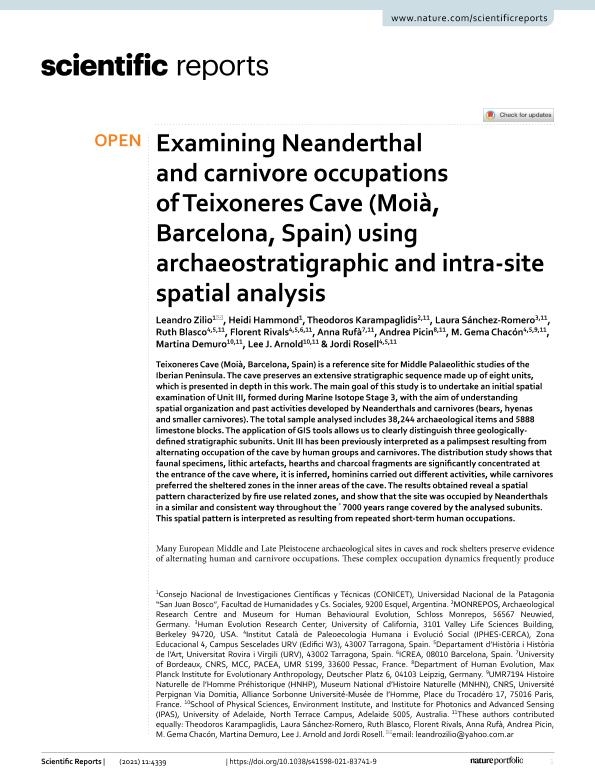Mostrar el registro sencillo del ítem
dc.contributor.author
Zilio, Leandro

dc.contributor.author
Hammond, Heidi

dc.contributor.author
Karampaglidis, Theodoros
dc.contributor.author
Sánchez Romero, Laura
dc.contributor.author
Blasco, Ruth
dc.contributor.author
Rivals, Florent
dc.contributor.author
Rufà, Anna
dc.contributor.author
Picin, Andrea
dc.contributor.author
Gema Chacón, M.
dc.contributor.author
Demuro, Martina
dc.contributor.author
Arnold, Lee J.
dc.contributor.author
Rosell, Jordi
dc.date.available
2022-08-11T12:45:35Z
dc.date.issued
2021-02
dc.identifier.citation
Zilio, Leandro; Hammond, Heidi; Karampaglidis, Theodoros; Sánchez Romero, Laura; Blasco, Ruth; et al.; Examining Neanderthal and carnivore occupations of Teixoneres Cave (Moià, Barcelona, Spain) using archaeostratigraphic and intra-site spatial analysis; Nature Publishing Group; Scientific Reports; 11; 1; 2-2021; 1-20
dc.identifier.issn
2045-2322
dc.identifier.uri
http://hdl.handle.net/11336/165146
dc.description.abstract
Teixoneres Cave (Moià, Barcelona, Spain) is a reference site for Middle Palaeolithic studies of the Iberian Peninsula. The cave preserves an extensive stratigraphic sequence made up of eight units, which is presented in depth in this work. The main goal of this study is to undertake an initial spatial examination of Unit III, formed during Marine Isotope Stage 3, with the aim of understanding spatial organization and past activities developed by Neanderthals and carnivores (bears, hyenas and smaller carnivores). The total sample analysed includes 38,244 archaeological items and 5888 limestone blocks. The application of GIS tools allows us to clearly distinguish three geologically-defined stratigraphic subunits. Unit III has been previously interpreted as a palimpsest resulting from alternating occupation of the cave by human groups and carnivores. The distribution study shows that faunal specimens, lithic artefacts, hearths and charcoal fragments are significantly concentrated at the entrance of the cave where, it is inferred, hominins carried out different activities, while carnivores preferred the sheltered zones in the inner areas of the cave. The results obtained reveal a spatial pattern characterized by fire use related zones, and show that the site was occupied by Neanderthals in a similar and consistent way throughout the ˃ 7000 years range covered by the analysed subunits. This spatial pattern is interpreted as resulting from repeated short-term human occupations.
dc.format
application/pdf
dc.language.iso
eng
dc.publisher
Nature Publishing Group

dc.rights
info:eu-repo/semantics/openAccess
dc.rights.uri
https://creativecommons.org/licenses/by/2.5/ar/
dc.subject
NEANDERTHALES
dc.subject
CARNIVORES
dc.subject
MIDDLE PALAEOLITIC
dc.subject
INTRA-SITE SPATIAL ANALYSIS
dc.subject.classification
Arqueología

dc.subject.classification
Historia y Arqueología

dc.subject.classification
HUMANIDADES

dc.title
Examining Neanderthal and carnivore occupations of Teixoneres Cave (Moià, Barcelona, Spain) using archaeostratigraphic and intra-site spatial analysis
dc.type
info:eu-repo/semantics/article
dc.type
info:ar-repo/semantics/artículo
dc.type
info:eu-repo/semantics/publishedVersion
dc.date.updated
2022-08-09T17:31:35Z
dc.journal.volume
11
dc.journal.number
1
dc.journal.pagination
1-20
dc.journal.pais
Reino Unido

dc.journal.ciudad
Londres
dc.description.fil
Fil: Zilio, Leandro. Consejo Nacional de Investigaciones Científicas y Técnicas; Argentina. Universidad Nacional de la Patagonia "San Juan Bosco"; Argentina
dc.description.fil
Fil: Hammond, Heidi. Universidad Nacional de la Patagonia "san Juan Bosco". Facultad de Humanidades y Cs.sociales - Sede Esquel; Argentina. Consejo Nacional de Investigaciones Científicas y Técnicas; Argentina
dc.description.fil
Fil: Karampaglidis, Theodoros. Archaeological Research Centre and Museum for Human Behavioural Evolution; Alemania
dc.description.fil
Fil: Sánchez Romero, Laura. University of California; Estados Unidos
dc.description.fil
Fil: Blasco, Ruth. Universitat Rovira I Virgili; España
dc.description.fil
Fil: Rivals, Florent. Berkeley University; Estados Unidos
dc.description.fil
Fil: Rufà, Anna. Université de Bordeaux; Francia
dc.description.fil
Fil: Picin, Andrea. Max Planck Institute for Evolutionary Anthropology; Alemania
dc.description.fil
Fil: Gema Chacón, M.. Universitat Rovira I Virgili; España
dc.description.fil
Fil: Demuro, Martina. University of Adelaide; Australia
dc.description.fil
Fil: Arnold, Lee J.. University of Adelaide; Australia
dc.description.fil
Fil: Rosell, Jordi. Universitat Rovira I Virgili; España
dc.journal.title
Scientific Reports
dc.relation.alternativeid
info:eu-repo/semantics/altIdentifier/url/http://www.nature.com/articles/s41598-021-83741-9
dc.relation.alternativeid
info:eu-repo/semantics/altIdentifier/doi/http://dx.doi.org/10.1038/s41598-021-83741-9
Archivos asociados
